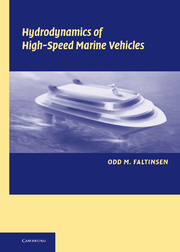Book contents
- Frontmatter
- Contents
- Preface
- List of symbols
- 1 INTRODUCTION
- 2 RESISTANCE AND PROPULSION
- 3 WAVES
- 4 WAVE RESISTANCE AND WASH
- 5 SURFACE EFFECT SHIPS
- 6 HYDROFOIL VESSELS AND FOIL THEORY
- 7 SEMI-DISPLACEMENT VESSELS
- 8 SLAMMING, WHIPPING, AND SPRINGING
- 9 PLANING VESSELS
- 10 MANEUVERING
- APPENDIX: Units of Measurement and Physical Constants
- References
- Index
APPENDIX: Units of Measurement and Physical Constants
Published online by Cambridge University Press: 15 September 2009
- Frontmatter
- Contents
- Preface
- List of symbols
- 1 INTRODUCTION
- 2 RESISTANCE AND PROPULSION
- 3 WAVES
- 4 WAVE RESISTANCE AND WASH
- 5 SURFACE EFFECT SHIPS
- 6 HYDROFOIL VESSELS AND FOIL THEORY
- 7 SEMI-DISPLACEMENT VESSELS
- 8 SLAMMING, WHIPPING, AND SPRINGING
- 9 PLANING VESSELS
- 10 MANEUVERING
- APPENDIX: Units of Measurement and Physical Constants
- References
- Index
Summary
The fundamental units of measurement in mechanics are mass, length, and time. The basic units in the SI system are kilograms (kg), meters (m), and seconds (s) for mass, length, and time, respectively. Special names are given to derived units in the SI system. The unit force is one newton (N), which is equal to one kilogram-meter per second squared (kgms−2). One pascal (Pa) is the unit of pressure and stress. This is the same as one newton per meter-squared (Nm−2). The unit of work or energy is one joule (J), that is, one newton-meter (Nm). The unit power is one watt (W), equal to one joule per second (Js−1). Prefixes denote decade factors, such as kilo- (k) for 103, mega- (M) for 106, giga- (G) for 109, tera- (T) for 1012, centi- (c) for 10−2, milli- (m) for 10−3, and micro- (μ) for 10−6.
Table A.1 presents the relationship between the SI system and some other commonly used measurement systems. Table A.2 lists values of density and viscosity of water and air, whereas Table A.3 shows how the vapor pressure varies with the temperature. The standard acceleration of gravity (g) is equal to 9.80665 ms−2. The standard atmospheric pressure at sea level is 1.01325 × 105 Nm− 2. The surface tension of the interface between air and water varies between 0.076 Nm− 1 and 0.071 Nm−1 for the temperature range 0° to 30°C.
- Type
- Chapter
- Information
- Hydrodynamics of High-Speed Marine Vehicles , pp. 435 - 436Publisher: Cambridge University PressPrint publication year: 2006



